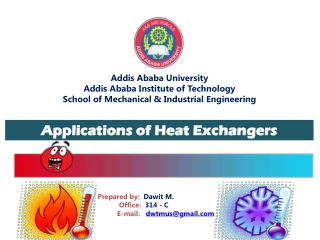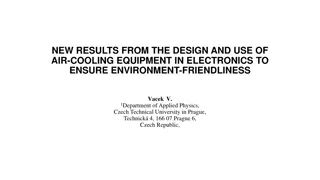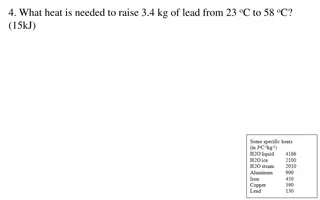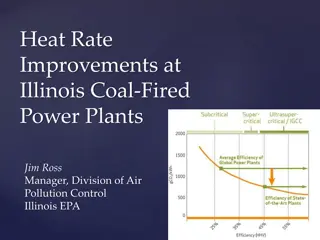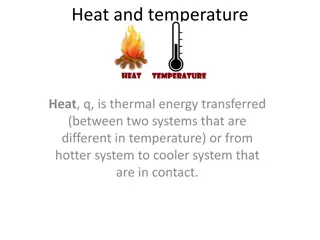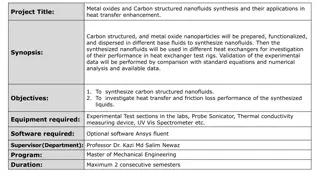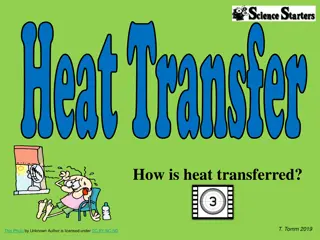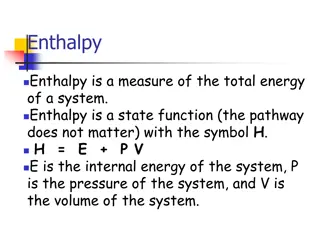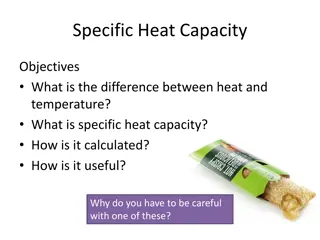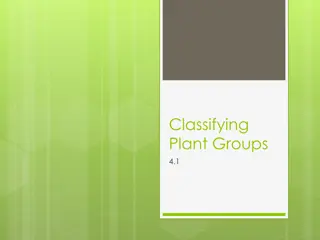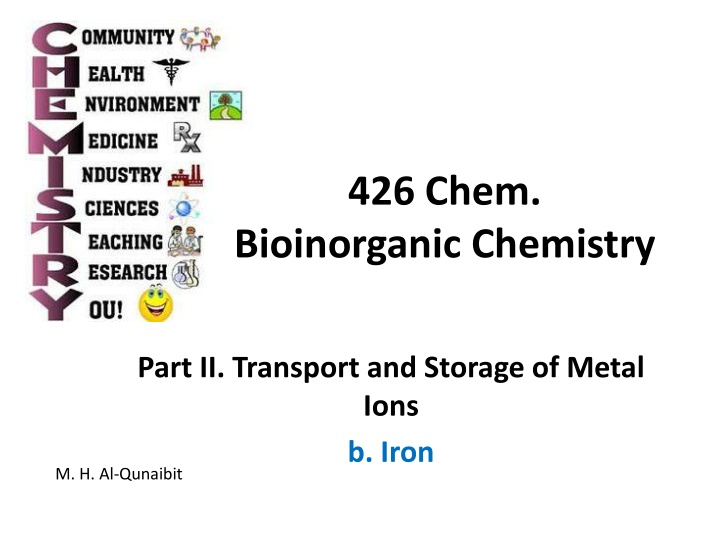
Heat Exchangers: Essential Components for Industrial Plants
Heat exchangers play a pivotal role in various industries by facilitating the transfer of heat between fluids without direct contact. There are different types of heat exchangers such as double-pipe exchangers and shell-and-tube heat exchangers, each with its own unique design and applications. Understanding the main components, terms, and functionalities of heat exchangers is crucial for efficient heat transfer processes in industrial settings.
Download Presentation

Please find below an Image/Link to download the presentation.
The content on the website is provided AS IS for your information and personal use only. It may not be sold, licensed, or shared on other websites without obtaining consent from the author. If you encounter any issues during the download, it is possible that the publisher has removed the file from their server.
You are allowed to download the files provided on this website for personal or commercial use, subject to the condition that they are used lawfully. All files are the property of their respective owners.
The content on the website is provided AS IS for your information and personal use only. It may not be sold, licensed, or shared on other websites without obtaining consent from the author.
E N D
Presentation Transcript
426 Chem. Bioinorganic Chemistry Part II. Transport and Storage of Metal Ions b. Iron M. H. Al-Qunaibit
Outline- Part II b The chemistry of iron The biological role of Fe Ferritin, the cellular Fe store Oxygen transport Myoglobin Hemoglobin 426 Chem. Part II b 2
Oxidation states of Fe Fe, Z=26, 1s22s22p63s23p63d64s2 The chemistry of iron is dominated by the +2 and +3 oxidation states. They form complex ions with selected ligands, usually of an octahedral shape, and a few tetrahedral iron(III) complexes exist. FeIII is stabilized by negatively charged ligands. FeII is favored by neutral ligands which allow some charge delocalization in -orbitals. 426 Chem. Part II b 3
Fe3+ complexes At low pH, hydrolysis occurs(it is a complicated process and mixture, especially in presence of coordinating anions). FeIII salts dissolve in water producing high acidity, and the hexaquo ion predominates at very low pH ~0 (pale-violet) At pH 2-3 color becomes yellow due to hydrolyzed species. 426 Chem. Part II b 4
Fe3+ complexes At pH > 2-3, colloidal gels form reddish- brown precipitate of hydrous iron(III) oxide FeIII form complexes with a variety of ligands, but has a marked preference to O-donor ligands 426 Chem. Part II b 5
Fe2+ complexes [Fe(H2O)6]2+ ion is pale green No hydrolysis in acidic solutions FeII forms complexes with a variety of ligands. These complexes are less stable than those with FeIII (smaller cationic charge) 426 Chem. Part II b 6
The FeIII/FeII couple Fe3+ + e Fe2+ The standard reduction potential E value for the couple involving the simple aquated ions shows that: The FeII(aq) is thermodynamically stable with respect to hydrogen. FeIII(aq) is spontaneously reduced by hydrogen gas. FeII(aq) is oxidized to FeIII(aq) by atmospheric oxygen under certain circumstances. Oxidation is slow in acidic solutions 426 Chem. Part II b 7
The FeIII/FeII couple E changes with alkalinity increase and precipitation of Fe(III) species occur. Fe(II) solutions are not stable with respect to areal oxidation. 426 Chem. Part II b 8
Which oxidation state of iron you think will be best utilized in biological systems? Why? 426 Chem. Part II b 9
Outline- Part II b The chemistry of iron The biological role of Fe Ferritin, the cellular Fe store Oxygen transport Myoglobin Hemoglobin 426 Chem. Part II b 10
The Biological role of iron Iron is an essential element in our diet and is needed for the production of haemoglobin. The iron atom in the haemoglobin molecule helps coordinate of the oxygen molecule and hence the transportation of oxygen around the body to the cells of all the tissues. Iron deficiency causes anaemia. Plants require iron for the synthesis of chlorophyll. 426 Chem. Part II b 11
Selective transport and storage of iron Iron is essential for almost all life forms, and is difficult to obtain. Any excess presents a serious toxic risk. Nature has at least two problems in dealing with this element: The first is the insolubility of Fe(III) (the stable oxidation state found in most minerals). As the pH increases, hydrolysis, polymerization, and precipitation of hydrated forms of the oxide occur. 426 Chem. Part II b 12
Selective transport and storage of iron The second problem is the toxicity of free-Fe species, particularly through the generation of OH radicals. In biological systems, Fe: Uptake into organisms involves special ligands known as siderophores (iron carriers/special ligands). Transport in the circulating fluids of higher organisms requires a protein called transferrin Is stored as ferritin. Citrate hydroxamate siderophore 426 Chem. Part II b 13
Why does iron uptake into organisms involve special ligands? 426 Chem. Part II b 14
Outline- Part II b The chemistry of iron The biological role of Fe Ferritin, the cellular Fe store Oxygen transport Myoglobin Hemoglobin 426 Chem. Part II b 15
Ferritin Ferritin is the principal store of non-heam Fe in animals (most Fe is occupied in heamoglobin and myoglobin) It occurs in all types of organism (in mammals in the spleen and in blood). Ferritins have two components: - a mineral core that contains up to 4500 Fe atoms (mammalian ferritin). - and a protein shell (apoferritin). 426 Chem. Part II b 16
Ferritin The mineral core is composed of: - hydrated Fe(III) oxide (ferrihydrite) - varying amounts of phosphate, which helps anchor it to the internal surface. The structure resembles that of the mineral ferrihydrite, 5Fe2O3.9H2O, which is insoluble and Fe must be mobilized. 426 Chem. Part II b 17
Ferritin Ferrihydrite: (5Fe2O3.9H2O) Based on an hcp array of O2- and OH- with Fe(III) layered in both the octahedral and tetrahedral sites. 426 Chem. Part II b 18
Ferritin The proposed mechanism for the reversible incorporation of Fe in ferritin involves: transport in and out as Fe(II), perhaps as the Fe2+ ion, which is soluble at neutral pH, but more likely with some type of chaperone complex. 426 Chem. Part II b 19
Ferritin Oxidation to Fe(III) involves: The coordination of O2 and inner-sphere electron transfer reaction: 2 FeII + O2 + 2H+ 2 FeIII + H2O2 The mechanism by which Fe is released almost certainly involves its reduction back to the more mobile Fe(II). 426 Chem. Part II b 20
Suggest a cycle representing the mobility of iron in and out of storage. 426 Chem. Part II b 21
Outline- Part II b The chemistry of iron The biological role of Fe Ferritin, the cellular Fe store Oxygen transport Myoglobin Hemoglobin 426 Chem. Part II b 22
Dioxygen As the waste product of photosynthesis, O2 is a biogenic substance, one that comes from solar energy capture by living organisms. Great thermodynamic advantage of having such a powerful oxidant available led to the evolution of higher organisms that now dominate Earth. The requirement for O2 needs special systems for transporting and storing it. 426 Chem. Part II b 23
Dioxygen There is difficulty in supplying O2 to buried tissue, and achieving sufficiently high concentration in aqueous environments which was overcame by: Metalloproteins known as O2 carriers . In mammals and most other animals and plants, these special proteins (myoglobin and heamoglobin) contain an Fe porphyrin cofactor. 426 Chem. Part II b 24
Dioxygen Some lower invertebrates use an alternative type of Fe protein, heamerythrin, which contains a dinuclear Fe site. Some primitive animals such (e.g. molluscs and arthropods) use a Cu protein called heamocyanin. What does the word heam (heme) mean? 426 Chem. Part II b 25
Myoglobin Is an Fe2+ protein that coordinates O2 reversibly and controls its concentration in tissue. In mammals, O2 (by respiration) is: carried in the bloodstream by heamoglobin and is stored in the tissues in myoglobin. 426 Chem. Part II b 26
Myoglobin Structure: The molecule contains several regions with the single Fe porphyrin group (heam group) located in a cleft between two helices. 426 Chem. Part II b 27
Myoglobin Fe is coordinated to four N-donor atoms in the porphyrin ring. The fifth ligand to the Fe is provided by a histidine-N. The sixth position is the site at which O2 is coordinated. 426 Chem. Part II b 28
Myoglobin Deoxymyoglobin is 5-coordinate, high-spin, and Fe2+ lies above the ring plane. When O2 binds it is coordinated end-on to the Fe atom. The unbound end of O2 is fastened by a hydrogen bond to the imidazole-NH. The coordination of O2 (a strong-field - acceptor) causes the Fe(II) to switch from high spin (t2g4eg2) to low-spin (t2g6) 426 Chem. Part II b 29
Myoglobin Coordination by O2 causes the Fe to: Become low spin (smaller radius). Move into the plane of the porphyrin ring accordingly. 426 Chem. Part II b 30
Myoglobin Interaction between iron centers is prevented by a so-called picket-fence porphyrin. 426 Chem. Part II b 31
Hemoglobin Hemoglobin consists of a tetramer of myoglobin-like subunits with four Fe sites that bind O2 cooperatively. 426 Chem. Part II b 32
Hemoglobin Although each of the four units in heamoglobin contains a heam group, the four groups do not operate independently of each other, and binding (and release) of O2 is a cooperative process: As the tetramer binds successive O2 molecules, the affinity of the vacant heam groups for O2 increases such that the affinity for the fourth site is ~ 300 times that of the first heam unit. 426 Chem. Part II b 33
Hemoglobin When O2 is released from hemoglobin to myoglobin, the loss of the first O2 molecule triggers the release of the remaining three. Myoglobin does not exhibit this cooperative effect since it comprises only one protein chain. 426 Chem. Part II b 34
Construct a comparison between haemoglobin and myoglobin. 426 Chem. Part II b 35
Video links https://www.youtube.com/watch?v=Zro- MR2Mjak https://www.youtube.com/watch?v=HdR- U0gMIi4 426 Chem. Part II b 36
Toxicity of CO and CN- Carbon monoxide: CO is small enough to fit into the protein cavity and form such strong bonds with the iron that the process is irreversible. High concentrations of CO rapidly use up the body's limited supply of hemoglobin molecules, and prevent them from binding to oxygen. Hemoglobin s binding affinity for CO is 200 times greater than for O2. 426 Chem. Part II b 37
Toxicity od CO and CN- Cyanide ion: Once cyanide is taken into the blood stream the majority (92-99%) is found bound to hemoglobin in red blood cells. Then CN- is taken to the body's tissues where it binds to an enzyme called cytochrome oxidase and stops cells from being able to use oxygen. 426 Chem. Part II b 38
Toxicity od CO and CN- Different mechanisms: Cyanide dissociates from hemoglobin faster than carbon monoxide and much slower than the dissociation rate constants for oxygen. Because of the extremely low affinity of CN- ligand for the ferrous heam iron, the dissociation occurs. Why? 426 Chem. Part II b 39


